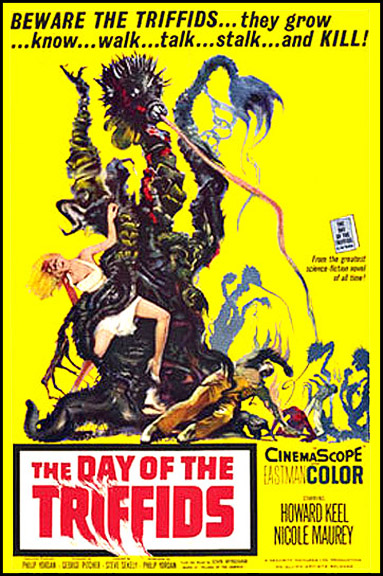mark mclaughlin
FOUR-LETTER WORD BEGINNING WITH `F'
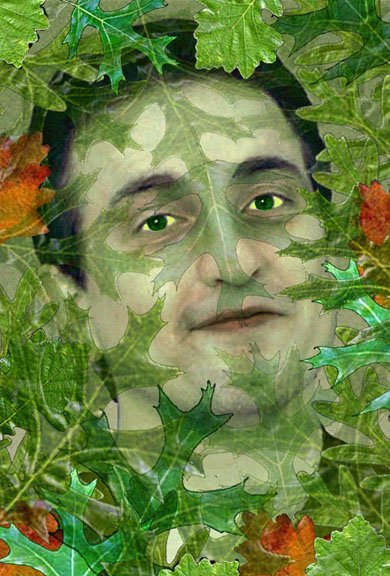
Mark McLaughlin's fiction, nonfiction and poetry have appeared in hundreds of magazines, anthologies, and websites, including The Living Dead 2, Cemetery Dance, Dark Arts, Midnight Premiere, Fangoria, Horror Garage, FilmFax, Shroud Magazine, ChiZine.com, The Black Gate, Galaxy, all three Bending the Landscape volumes, and two volumes each of The Best of the Rest, The Best of HorrorFind, and The Year's Best Horror Stories, as well as The Book of All Flesh, its two companion volumes, and The Best of All Flesh. Collections of his fiction include Death Creeps In On Velvet Paws, Twisted Tales For Sick Puppies, Raising Demons For Fun and Profit, Slime After Slime, Pickman's Motel, Motivational Shrieker, and At the Foothills of Frenzy (with co-authors Shane Ryan Staley and Brian Knight). He is the co-author, with Rain Graves and David Niall Wilson, of The Gossamer Eye, which won a Bram Stoker Award for Poetry. His collaborative novel with Michael McCarty, Monster Behind the Wheel, was a Bram Stoker Award Finalist for Best First Novel. Mark's works can be found at www.MerchantsKeep.com, www.Horror-Mall.com, and the Anthologies Section of www.GenreMall.com. Visit Mark on the web at www.facebook.com/MarkMcLaughlinMedia, www.myspace.com/monsterbook, and www.youtube.com/mcmonsterbook.
Floraphobia:
Horror Takes Root
Welcome once again to my gruesome garden of grisly gore, where we discuss fear as it is manifested in the cinema of the macabre.
One might think a person wouldn't have cause to experience Floraphobia, or an intense fear of plants. But in fact, a person would be WRONG to think such a thing. Us meat-based bipeds have plenty of reasons to fear the green life-forms that share our world.
Quite simply, plants hate us and can hurt or even kill us. Why do plants hate us? Let me count the ways:
1. We eat their various stems and stalks and leaves... their bodies!
2. We eat grain... their seeds, which are their babies!
3. We chop down living trees, saw up their giant corpses and make stuff out of them!
4. We mow the grass on lawns... entire legions of their kind... because we like it short and tidy!
5. Worst of all, we pick flowers... which are, technically, their genitalia... and use them as decorations! Would you like it if somebody yanked off your genitals and put them in a vase? Probably not!
How can plants hurt or kill us? I can count those ways, too:
1. Pollen can give us allergy attacks and make us miserable!
2. Many plants are poisonous!
3. Mold and fungi can grow on us and make us sick!
4. Thorns can rip our flesh!
5. Limbs can break off of trees, fall on us and kill us!
So while most people might say they are not afraid of plants... deep down, at some primal level, they probably realize that plants aren't really our friends. Consider this: When we die, our dead bodies in the ground supply nourishment to the hungry roots of trees. Is that what you'd call a friend -- somebody who would eat your body after you died? I think not!
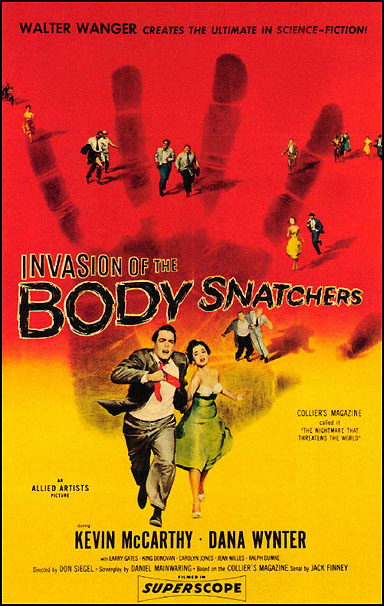
Certainly the most famous evil-plant movies of all would have to be Invasion of the Body Snatchers (1956) and its various remakes and rip-offs. Alien plants quietly replicate and replace human bodies while their owners are sleeping. The process is rather complicated and involves big pods (hence the term ‘pod people' which is often associated with the movies).
The replicant may look like the victim, but he or she acts very cold and distant, and this plant-like lack of warmth and personality tips off loved ones that something is afoot... or aroot, as the case may be.
This quiet sort of invasion has always been terrifying to Americans who fear that Communists or other subversive political forces are trying to infiltrate the Red, White and Blue. In the case of the pod people, they would see the colors of America's future as Green, Green and More Green.

Of course, in tropical locales, green is always the color of the day. In The Ruins (2008), a gang of young adventurers are trapped in an ancient jungle temple overrun with hungry, body-invasive killer vines. This theme, plants invading bodies, is played to morbid perfection in Mortuary (2005). In Mortuary, a single mother decides to start over as a mortician. Not exactly the best career move for turbo-charging her social life, but it might give her the inside track on meeting eligible widowers.
Unfortunately, the building she buys for her new business is infested with a supernatural mildew that preys on the living and the dead, turning them into zombies with a fairly high degree of predatory intelligence. Their main goal is to infect others, and they do so to forward the goals of the Lovecraftian mildew god dwelling in the mortuary's sub-cellars.
Most people already detest mold and mildew because it is so filthy, slimy and sickening, and this movie will have you scrubbing the bathroom tiles with renewed vigor.
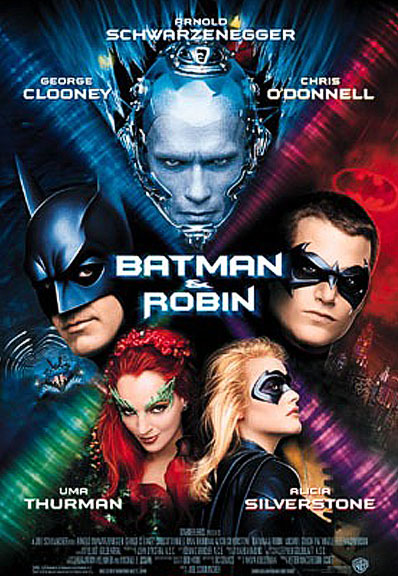
Batman and Robin (1997) features the super-villain Poison Ivy, who taps into humankind's most unusual fear: that a sexy plant-woman will try to destroy the world through rampant over-acting. Uma Thurman plays the part like a crazy three-way cross between Mae West, RuPaul and a giant, estrogen-saturated begonia.
The Mutations, a.k.a. The Freakmaker (1974) concerns a mad scientist who finds out how to turn people into plant monsters and various other humanoid oddities -- he even creates a market for them, because he sells his mutated failures to a local freak show.
The Revenge of Dr. X (1970) is like an odd chapter of the Mighty Morphin Power Rangers gone haywire. There are no Rangers, but there's a great fake monster and lots of goofy pseudo-science. A respected scientist goes on vacation and decides to create a missing-link plant-man. Yeah, that's the sort of to-do list item we all decide to tackle when we take some time off, right?
So, he creates Mr. Goodvine while visiting the island of Japan. The man-plant monster has Venus-flytrap hands, a body like a buff superhero, and a fleshy tangle of roots for a head. Now, wouldn't you create a monster like that at your permanent residence... not while kicking back in a guest-house in a foreign country? What's he supposed to do with the monster when his vacation is over? Buy it a plane ticket for the long ride home?
The Maneater of Hydra (1967) is the pet of a different mad scientist on a different island -- namely, the Mediterranean island of Hydra. This scientist orchid-strates... ummm, I mean, orchestrates... the death of a batch of nosy tourists, one by one, so he can hide the secret of his man-eating tree. But considering that this tree is firmly rooted. it really isn't much of a threat. All you have to do to escape its deadly grasp is back up a few feet, out of its leafy reach.
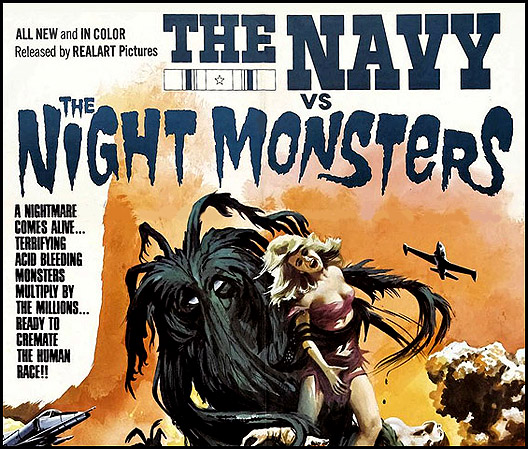
Navy Vs. The Night Monsters (1966) also features deadly trees, but backing away from these murderous maples won't automatically save you, because they are ambulatory and can give chase... albeit rather slowly. If you are capable of going faster than, say, three miles an hour, you can easily save yourself.
These catastrophic catalpa trees of calamity are survivors of prehistoric times, dug up from their frozen slumber in Antarctica by snoopy military scientists. The scientists transfer them to a warmer locale and that's when the monstrous merriment begins. Blonde bombshell Mamie Van Doren is on hand to flirt with the militia and scream prettily every now and then.
While the Night Monsters are angry left-overs from Earth's prehistoric days, the ambulatory killer hell-blossoms in Day of the Triffids (1962) are invaders from outer space. They arrive on our planet along with a meteor shower that blinds most of the Earth's residents with its eerie brilliance.
That widespread blindness turns humanity into easy pickin's for the Triffids, who tower over people and attack with savage gusto. Fortunately, some plucky Earthlings discover the one thing that Triffids cannot stand. It's always nice when aliens have a convenient Achilles heel, like the germ-susceptible Martians in War of the Worlds.
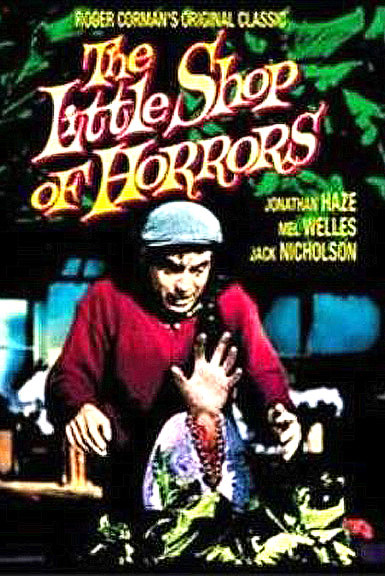
The ultimate alien plant invader, however, would have to be Audrey II, the singing, growing, over-eating carnivorous plant in the campy musical, Little Shop of Horrors (1986), based on a cheap but energetic old non-musical Roger Corman production (1960) with the same title, except with THE at the beginning.
Audrey II starts out as cute little potted plant, found and fostered by a nerdy knucklehead named Seymour, who is desperately in love with shopgirl Audrey, the plant's namesake. Audrey II grows bigger and hungrier, and Seymour does whatever it takes to help his precious sprout to thrive.
In time, Seymour extricates Audrey from an abusive relationship by feeding her bastard of a beau to Audrey II -- but the ravenous rhododendron sees this offering as a trifling hors d'oeuvre. Eventually Seymour and Audrey II have it out in a musical man-versus-monster showdown.
Interesting note: Audrey II has a booming singing voice, and when backup singers are needed, the over-sized carnivorous corsage simply grows them!
So the next time you venture outdoor, beware... for while plants may not have eyes as we know them, they can still sense your presence and can hardly wait to sink their roots into you and draw out your nutrients. Thankfully, the most lethargic of living persons is fast enough to escape the plants.
But who knows...? Someday, perhaps, environmental changes may speed up the plants. That would be truly devastating, when one considers that the plants far outnumber us. People say that money is the root of all evil, but if the plants ever accelerate their act, surely the root of all evil will then be... roots!
END













